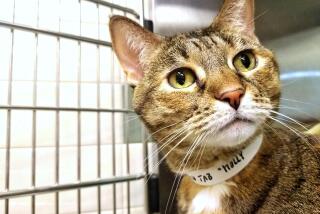Note to cats: Lay off the birds
- Share via
Sometimes, an animal protection issue has a clear moral path to follow, notes Wayne Pacelle, the chief executive of the Humane Society of the U.S. But other times, he writes on his blog, “the protection of one species appears to conflict with the protection of another.”
He was talking about birds and feral cats. And once again, the conflict between the two species is in the spotlight. A new report, published in the online journal Nature Communications and based on a systematic review of existing studies, estimates that “free-ranging domestic cats kill 1.4-3.7 billion birds” annually in the United States. That’s not counting another 7 billion to 20 billion other small mammals including, but not limited to, mice.
Most of that carnage is being laid at the paws of homeless cats that live on the street, often feral and unsocial.
Although my last cat always lived indoors, I got glimpses of the predator he could be. Staring at a bird outside the window of our home, he would widen his mouth and go into a spasm of teeth chattering. I relied on my cat to mercilessly stalk and do away with the giant cockroaches that sometimes crept into my old apartment in Washington.
I don’t want cats slaughtering birds any more than I want shelters across the nation killing millions of unwanted cats, as they do each year. But trapping and killing feral cats is cruel. And rounding up feral cats and sending them off to city and county shelters is essentially the same death sentence. Because feral cats are usually too scared of people to be socialized, they are rarely adopted out and almost always euthanized.
The approach that many animal welfare groups, including the Humane Society, support is the trap-neuter-return (or release) program, in which feral cats are trapped and neutered or spayed and designated as such with a notch on the tip of the ear. They are then returned to the place where they were caught.
Bird protection groups, as well as the authors of the recent journal piece, contend that trapping and neutering is not diminishing the number of feral cats.
However, some studies indicate otherwise. A 2003 report in the Journal of the American Veterinary Medical Assn. tracked a TNR program on a Florida collage campus for 11 years and found the cat population decreased by 66%.
For now, trapping and neutering is the most humane method for coping with feral cats. And if cats are such stealthy predators that they can surprise birds possessed of the power to fly away, then maybe feral cats captured for neutering should also be outfitted with noisy bell collars before being returned to the outdoors.
But this is only one aspect of dealing with potential feline predators. Virtually all animal welfare advocates urge cat owners to keep their pets indoors, to protect not just wildlife but the cats themselves, which face plenty of life-threatening danger outside from cars, dogs, other cats and coyotes.
My editorial board colleague, Karin Klein, and I don’t agree on how to solve the problem of cats and birds, but I fully support her call for stricter rules on cat ownership, including licensing them.
And though birds’ primary source of trouble is feline, they face other threats that we could work to reduce: loss of habitat, pollution, pesticides. Even the recent study doesn’t dismiss these other threats and says they should be quantified and minimized.
In some cases, feral colonies near sensitive wildlife areas can be relocated. But it can be difficult. Few citizen groups can undertake the elaborate and expensive effort by government agencies and private groups in recent years to remove 59 feral cats from the Navy-owned San Nicolas Island off Southern California. The cats, which were threatening endangered wildlife, were taken by the Humane Society to its Fund for Animals Wildlife Center near San Diego.
Domesticated cats -- and I include roaming feral felines in that category -- may not be native wildlife like many birds in the area, but they were brought here by humans and have been our companions for centuries. It’s bad enough that irresponsible owners discard cats by letting them loose or surrendering them to shelters. In Los Angeles city-run shelters alone, from July 2011 to June 2012, 21,882 cats -- unweaned kittens, unwanted adults, ferals -- were taken in. About 57% were euthanized, according to the Department of Animal Services, which (to its credit) posts its statistics. For people who care about all felines, homeless cats are not merely bird-stalking varmints.
Also, feral cats serve a purpose in some situations. They are an excellent deterrent against rats and have been used for that in urban environments. They essentially eradicated rats in the downtown flower district. (And they don’t even have to kill. The rats smell the cats and go away.)
We do need to better manage and control our feral cat colonies. And we also need to do a better job of tending all of our cats. And that starts with keeping them inside and never turning them out into the streets.
ALSO:
Of Jim Nabors, stress-free gays and sexy Super Bowl ads
More to Read
A cure for the common opinion
Get thought-provoking perspectives with our weekly newsletter.
You may occasionally receive promotional content from the Los Angeles Times.











